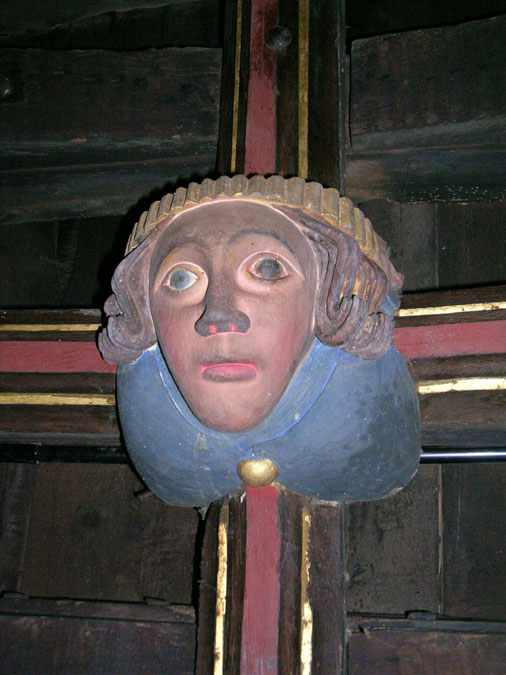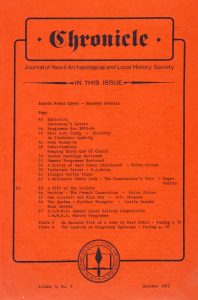This article came from the Chronicle published October 1985. Pages 46-49
NEWS ROUND-UP
ASH, NEAR MARTOCK. During the 1985 August bank holiday weekend an excellent exhibition was held in Ash village hall to celebrate 90 years since the Parish Council was initiated. The wide ranging exhibition also covered the neighbouring hamlets of Milton (Fauconberg), Witcombe and Stapleton. The show piece was a late Victorian farm kitchen/living room set up on the stage. Individual stands featured Ash Primary school, gloving in the district, Holy Trinity Church, old farm hand tools, J.P. Rodford – a village carpenter, field names past and present etc. Of special interest was the display of stone mason’s tools entitled – “Village Builder – F.J.T. England”. This was supported by three albums showing recent work including many good photographs of restoration work at Yeovil St. John’s. A related contribution described Britannia House in Back Lane. This splendid modern building has been constructed by the same company of stone masons incorporating old material. Much of the facade and the stone fireplace of 1640 came from the Britannia Inn, which formerly stood in Vicarage Street, Yeovil. A photograph of Leslie Brooke’s drawing of the Inn was used in the display, (identical to the illustration in the last edition of Chronicle). In the back wall is located the rose window from Long Load Weslyian chapel and other material came from the demolished Cartgate railway bridge. Two items of aeronautical interest were included. One was a letter from the Cornwall Aviation Co. of St. Austell about “passenger and exhibition flying” to take place in a field off Foldhill Lane in 1931. The other concerned the exploits of Graham Gilmour. In a letter to the editor of the Aeronautical Society Journal he describes an epic flight from Bristol to Sherborne via Martock and Yeovil. Unfortunately, in neither case was the type of aeroplane mentioned. There were extensive displays of new and original maps and many good photographs of indiviaual buildings. Of particular note was Court Cottage – near the pound just south of Milton. It has its origins in a chapel built by Peter de Fauconberg in 1287. This exceptional exhibition was complemented by a well produced souvenir guide. There must be almost unlimited scope for other communities to follow the splendid example set by “ASH 90”
BRISTOL: ST. MARY REDCLIFFE. It is understood that in early June a number of mediaeval grave stones with incised decoration and a mediaeval stone coffin were broken up with sledge-hammers anal removed in a skip. The remains were dumped in a quarry near Bristol Airport and rapidly buried under thousands of tons of rubbish. No attempt was made to record the stones before their destruction, although it is possible that some of them are included amongst the illustrations in Paul’s “Incised & Sepulchral Slabs of North-West Somersetshire”. A letter to the Rector of St. Mary’s illicited a reply expressing regret for what had happened. The reason given for destroying the memorials was that they may have become broken by the frost and then used by vandals to smash the flood-lights. It is sad to reflect that mediaeval monuments are just as endangered in 1985 as they were during the zealous days of Victorian “restoration” or the purges of religious extremism.
EAST COKER. A survey of the inscriptions in the churchyard of St. Michaels was carried out by school children from East Coker School during the summer term. The children stuck valiantly to their task supervised by Moira Gittos. The incentive of having the results of the survey published in Chronicle added to the general enthusiasm and the outcome of their labours is to be found here (A Survey of East Coker Churchyard, Somerset – by Moira Gittos)
HENGISTBURY HEAD. Professor Barry Cunliffe has spent many seasons excavating the important pre-Roman site at Hengistbury Head, Dorset. The 1985 season has revealed evidence of a large Iron Large harbour complex dating from about 100BC. A sloping gravel ramp was found running down to deep water. Previous work on the site had suggested the probable existence of such a port to provide a vital trading link between free Britain and occupied Gaul.
ILCHESTER. In six weeks of concentrated activity a small team under the direction of Peter Leach of Birmingham University carried out a wide ranging series of excavations in Ilchester. The excavations were concentrated in three areas each. with a different historical context. At Castle Farm there was an unsuccessful attempt to locate buildings associated with the mediaeval Whitenall Nunnery. It is presumed that the main site lies beneath the existing farm and buildings. However, in this area a deep section was made through the western defences of the roman and mediaeval town. This revealed a different alignment than had previously been believed and has necessitated a re-appraisal of the historical map of Ilchester. At Pill Bridge Lane, a roman suburban development was revealed together with some late 4th century burials. On the site of the Iron Age Oppidum. (see An ‘Oppidum’ of the Durotriges at Ilchester – (by P. Leach)), a further excavation revealed the presence of a semi-circular timber house, just inside the stone-faced clay rampart.
LITTLE DEAN: GLOUCESTSHIRE. A team from Manchester University lead by Prof. Barry Jones have been excavating the only known Roman spring-head temple in Britain. The site, which is in the grounds of Dean Hall, in the Forest of Dean, was discovered by a local enthusiast Mr. Macer-Wright in January 1984. The temple measures some 23 metres by 35 metres with a large apse, and ambulatory round three sides of a courtyard. It dates from the 2nd to the 4th century AD. Dr. Anne Ross believes that the temple was probably associated with the Celtic god Sabrina, although evidence has not yet been found to confirm this.
MAIDEN CASTLE: DORSET. Excavation began at Maiden Castle in July under the direction of Niall Sharpies. Three of Sir Mortimer Wheeler’s original trenches will be re-opened so that modern techniques can be used to confirm the destruction of the hillfort by the Romans in 43 AD. The excavation is open to the public with daily guided tours available.
August 1985.
NORTH CADBURY. The dismantling of the early 15th century tomb at North Cadbury was recorded in the last issue of Chronicle. The monument has now been fully conserved and replaced in the church. It has been re-erected in a position just east of that it previously occupied so that its western end is now visible. A report of the project by the conservator involved appears in this issue.
POTTERNE: WILTS. A late bronze age midden (c 1000 – 700 BC) under excavation near Potterne is yielding important results because a degree of mineralization has allowed excellent preservation. Many seeds are present, both those used for food and others which are not normally represented. Bones from shorthorn cattle, sheep, deer, pig, dog and horse have been identified, while pieces of lead for use in alloys, crucible fragments and slag droplets all indicate that metal working was conducted. The midden overlays a slightly earlier occupation site.
SALISBURY MUSEUM. The Salisbury and South Wiltshire Museum has won a special award in this year’s “Museum of the Year Award”. The award scheme is sponsored by the Illustrated London News, National Heritage and Book Club Associates. It was worth £1000 and the Curator Peter Saunders was particularly pleased to have won in the face of outstanding competition from more glamourous enterprises such as the Burrell Collection (Glasgow) and the Viking Centre at York.
August 1985.
SHEPTON BEAUCHAMP. Restoration has been carried out on the “fives wall” at Shepton Beauchamp. The wall is constructed of Ham stone and stands 23 feet high. It is adorned with ball finials which have been replaced. It probably dates from the early 19th century and was once part of the courtyard of the New Inn which is now closed. The wall was donated to the parish council by Mr. Cecil Welsh. (Members had the opportunity of examining the “fives wall” at Hinton St. George in April- Ed.).
TAUNTON CASTLE. Workmen digging foundations as part of a conservation scheme near Taunton Castle last April, discovered the remains of a skeleton which was found to date from the tenth century. Archaeologists are considering the possibility that this is evidence of a Saxon burial ground at Castle Bow.
YEOVIL MUSEUM. Some time ago a bronze-age axehead was discovered on Wyndham Hill, with the aid of a metal detector. The plain bronze axe-head, of an early type, has now been purchased for the museum, where it has been placed on display.

